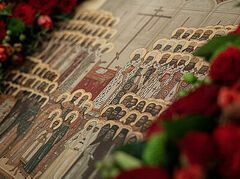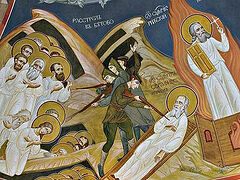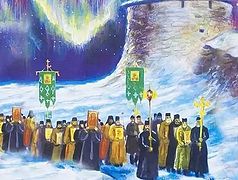 The Synaxis of the New Martyrs of Butovo
The Synaxis of the New Martyrs of Butovo
Archpriest Kirill Kaleda, the son of a secret priest and grandson of a New Martyr, talks about the New Martyrs of Butovo firing ground, and the people who executed them.
***
It can be said that this interview began with the Divine Liturgy in the Church of the New Martyrs and Confessors of the Russian Church at the former Butovo firing range in Moscow. The words of prayers were the “epigraph” to it. The rector of this church, Archpriest Kirill Kaleda, delivered a sermon on Hieromonk Pavel (Troitsky; † early November, 1991)—the spiritual mentor of his grandfather, Hieromartyr Vladimir Ambartsumov († 5.11.1937), who was slain here in Butovo. Fr. Kirill’s father, Archpriest Gleb Kaleda (1921–1.11.1994)—a secret priest who later began to preach openly and chose the difficult path of prison ministry. Fr. Kirill himself sought counsel of Elder Pavel, who had gone through the prisons and labor camps:
“Fr. Pavel did nothing without prayer. No matter what he was asked about, be it having a cup of tea or something that required spiritual discernment. He would step aside, pray and then give an answer. And he could literally reply that there is the will of God for someone to do such-and-such a thing.
 Hieromonk Pavel (Troitsky) “Like many of the brethren of the Moscow St. Daniel’s (Danilov) Monastery, Hieromonk Pavel (Troitsky) was arrested and exiled. In prison, when Fr. Pavel was in a state of complete exhaustion and dying, one of the prison wardens found an opportunity to release him. When one of the prisoners died just as his release papers had arrived, the warden simply swapped their documents.
Hieromonk Pavel (Troitsky) “Like many of the brethren of the Moscow St. Daniel’s (Danilov) Monastery, Hieromonk Pavel (Troitsky) was arrested and exiled. In prison, when Fr. Pavel was in a state of complete exhaustion and dying, one of the prison wardens found an opportunity to release him. When one of the prisoners died just as his release papers had arrived, the warden simply swapped their documents.
“Fr. Pavel returned to his native Tver region and spent the rest of his life in seclusion. He hardly contacted anyone, only corresponding with some of the clergy.
“There were many cases of Fr. Pavel’s clairvoyance. Here at the former Butovo firing range rest the relics of his spiritual son, Hieromartyr Vladimir Ambartsumov. In 1937, before his arrest, his son Yevgeny asked Elder Pavel, ‘I was offered to go on an interesting folklore expedition to the north under the guidance of a famous scientist...’ For a young man who was entering the Literary Institute it would have been a unique trip. But Fr. Pavel suddenly replied: ‘No, you shouldn’t go. Stay at home!’ And by obeying the elder, Yevgeny had the opportunity to spend his last summer with his father, because he (Hieromartyr Vladimir) was arrested in September...”
***
Such was the eve of “the Year of the Lord”—Liturgy in the Butovo wooden Church of the New Martyrs and Confessors of Russia, with a sermon about Hieromartyr Vladimir Ambartsumov’s last summer before he was slain here in Butovo. Then Fr. Kirill arranged a tour around the territory of the former Butovo firing range for all those who had prayed at the Liturgy, all the while answering their questions.
—Fr. Kirill, why is it easier for our contemporaries to comprehend the sanctity of the first martyrs who lived many centuries ago than that of the New Martyrs who are close to us in time?
—I think it is because, among the New Martyrs are mostly ordinary people. Even among the hieromartyrs there are many simple rural priests who served somewhere in the country’s backwoods, in small parishes. Each of them had some everyday problems of their own: a cow would be stolen, then something else would go wrong... And then he was interrogated, endured—and became a saint! On the face of it, there was nothing special in his life: he was an absolutely ordinary person. But he endured the trial and became a saint! This is the story of almost every new martyr. How many ordinary laymen and parishioners were among them! A person lived a simple, unremarkable life, tried to avoid sins like everyone else—nothing extraordinary... And suddenly he or she became a saint. This is why it is difficult for many to venerate them.
 Hieromartyr Constantine Uspensky Unfortunately, we don’t know much about the lives even of the canonized New Martyrs. But sometimes there are such touching stories! In Butovo, for example, Fr. Constantine Uspensky was executed by firing squad († 25.11.1937). He served in the Orekhovo-Zuyevo district near Moscow. He was charged with treating parishioners to apples from his orchard on the feast of Transfiguration of the Lord. On icons painted of him, he holds a basket of apples in his hands.
Hieromartyr Constantine Uspensky Unfortunately, we don’t know much about the lives even of the canonized New Martyrs. But sometimes there are such touching stories! In Butovo, for example, Fr. Constantine Uspensky was executed by firing squad († 25.11.1937). He served in the Orekhovo-Zuyevo district near Moscow. He was charged with treating parishioners to apples from his orchard on the feast of Transfiguration of the Lord. On icons painted of him, he holds a basket of apples in his hands.
—And he was canonized among the hosts of the New Martyrs right on the feast of the Transfiguration in 2000!1
—Correct. In fact, Russia especially demonstrated its holiness at the moment when Orthodoxy was persecuted and not when Orthodoxy was considered the State religion. It was when the Russian Church found itself on the brink of destruction that Russia shone with special power! This is the greatness of the podvig of the New Martyrs. We cannot perform such podvigs as did for example St. Paul of Thebes, the First Hermit. Who among us can live in the desert for ninety years? Who of us has such strong faith that a raven will bring us food every day? And who of us are such great fasters that we can live on a few crumbs of bread? Well, we’d last in solitude for a few months at most, and then run back headlong.
—How did the New Martyrs endure all that satanic malice, torture and mockery?
—In order to understand this better I’ll make the following comparison. Having fallen between the grinding stones of the system (which sooner or later happened to most of them), many of the Bolsheviks and Cheka2 officers broke down immediately because they didn’t understand what was happening. Imagine: A communist gets caught on the “conveyor belt” heading to an investigator. He thought he was fighting for the communist “bright future”, but he’s suddenly seized and declared an “enemy of the people”! In a sense, it was easier for believers to endure all this. Because the inner meaning of what was happening was clear to them. Some simple illiterate old woman would show much more courage in a secret torture chamber. Isn’t it amazing! She simply understood what was happening, what she was being tortured and murdered for. Maybe she wasn’t rejoicing—she’s also a human being. She felt pain—even if not physically (when they didn’t apply torture) but inwardly—because of what was happening, and her heart was sinking and bleeding. To rejoice when tortured is the next stage—that of the blessed. And there were many such people. In any case, those who understood what was happening bore their cross with dignity. Even if they fell under its weight, they would rise again and walk on...
—They walked on towards God. If it is in the Light of Christ that the religious meaning of suffering is revealed, and the New Martyrs displayed this Light at their Golgotha, did it touch the hearts of any executioners? Has the Church canonized at least one repentant persecutor among the multitudes of the New Martyrs?
—We, the Church community, haven’t yet attained such a level of love for love our persecutors as to canonize a repentant executioner who sealed his repentance with blood. Although there were cases when a person who had taken an active part in the Revolution repented sincerely and became religious. A striking example is Nikolai Evgrafovich Pestov († 14.01.1982).3
Just one amazing case...
—Have you ever spoken with any of the former Butovo NKVD4 officers?
—When in the mid-1990s an attempt was made to find out where the executions had taken place in Moscow, a man who in 1937 had acted as commandant of the NKVD Economic Administration in Moscow and the Moscow region was still alive. He confirmed that Butovo was indeed the main site of executions for Moscow and the Moscow region, and that the executioners who had signed the sentences of capital punishment for the 20,760 people found in the archives, had indeed “worked” at the Butovo firing range. So it became possible to determine that those people were shot in Butovo. In the overwhelming majority of other places, there is no such clear link. For example, there are a lot of questions regarding the burials in St. Petersburg; it is not clear who was killed in Levashovo and who was shot at the Rzhev firing range. That man left the Soviet agencies during World War II. He was a “manager” by nature; During the Civil War he ended up in the communist agencies as a teenager. He may have participated in something despicable—it was customary for NKVD members to “smear” all of their colleagues with blood. But, in any event, during WWII he left the system, and in the 1960s he worked as the director of what is now called the “ice show”.
An astonishing fact in that man’s story is that his second wife’s surname was typical for priests’ families! A year ago, his granddaughter, an Orthodox icon painter, came to visit us in Butovo. Two months before coming here she had learned that her beloved grandfather (whom she had actually considered a dissident) was what he was in the 1930s. It was easier for me to show President Putin around the former firing range than her. It was clear what I should say to the President, but it was absolutely unclear how I should speak with this poor woman.
I also saw a man from a neighboring village who had worked as a driver in the NKVD after the war.
By the way, “mobile gas chambers”, or “murder buses” (“dushegubki” in Russian)—vans in which an exhaust pipe was directed inside to the passengers, poisoning the condemned on the way so that by the time they arrived at the place of execution, they would too weak to offer any resistance—in fact weren’t invented by the Germans (as we were taught in Soviet schools). They were invented here, by Isay Davydovich Berg, who was responsible for carrying out sentences. And until the early 1950s, the above-mentioned driver from a neighboring village would bring the corpses of those who were shot or otherwised died in Moscow prisons. Therefore, far more than the 20,760 people we know of are buried in this place. Perhaps there were twice as many, but in any case at least 30,000 victims may lie here.
Many of the firing range employees themselves were imprisoned or shot; most became alcoholics, and some ended up in psychiatric hospitals. But I know of an amazing case when one of them repented and received Holy Communion on his deathbed.



